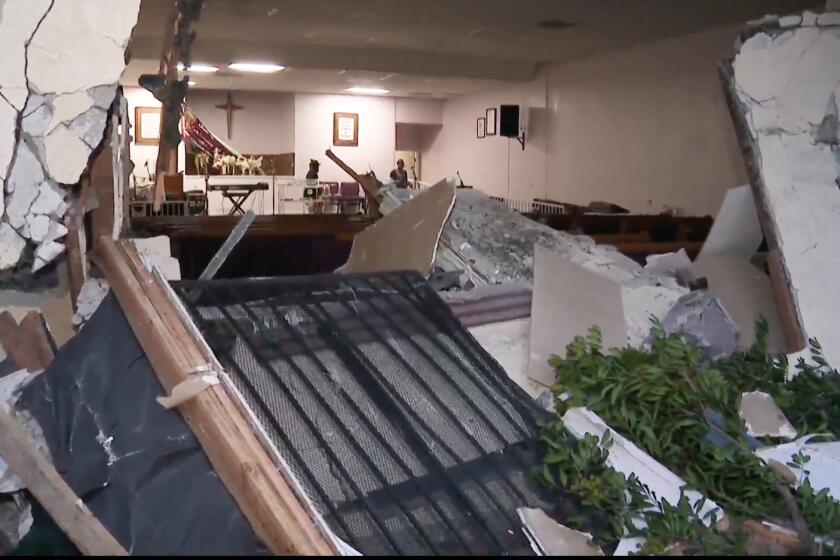Justices Restore Safeguards for Historic Homes
In a victory for preservationists, the California Supreme Court on Thursday barred cities from stripping buildings of historic-landmark status without environmental reviews.
The court decided unanimously that Sierra Madre improperly removed 29 buildings from a list of historic properties through a 1998 city-sponsored ballot measure.
More than 80 California cities and a statewide association of counties had urged the court to allow government agencies to change land use through ballot measures without environmental review. In fact, an attorney for Sierra Madre said government agencies have been doing that for 25 years.
The decision will affect all sorts of ballot measures by cities and counties. For instance, a county no longer will be able to put a general plan on the ballot for approval without having done a study of its environmental impact.
In an opinion written by Justice Marvin R. Baxter, the court said only citizen-placed initiatives are exempt from the California Environmental Quality Act, which requires a range of reviews, depending on how serious the environmental consequences appear to be.
Baxter contended that voters naturally assume that a measure placed on a ballot by a city council or board of supervisors has been studied for potential environmental effects.
“By contrast, voters have no reason to assume that the impact of a voter-sponsored initiative has been subjected to the same scrutiny,” he said, “and therefore will consider the potential environmental impacts more carefully in deciding whether to support or oppose the initiative.”
Sanford Svetcov, who represented Sierra Madre in the case, said the decision will make it more difficult for cities and counties to counter a citizen initiative with one of their own. Environmental reviews can be costly and time-consuming.
In Sierra Madre, the city would have had to spend about $75,000 to review the environmental effects of removing the 29 buildings, primarily private homes, from the protected list, he said.
Some property owners on the list complained that complying with the historic preservation law was too costly. Any changes that would affect the historic character of the home, including an addition, and, according to Svetcov, even a new roof, had to be approved by a historical commission.
“Those buildings are now back on the historic registry, subject to all regulatory control,” he said.
Susan Brandt-Hawley, who represented preservationists against the city, said the 29 buildings deserve protection and include homes by architectural giants Charles and Henry Greene and Irving Gill.
Most California cities have laws that restrict demolition of architecturally significant buildings, she said.
“Places that have revitalized historic districts give people a sense of place and community and often end up much more valuable” in price, she said.
State Atty. Gen. Bill Lockyer sided with the preservationists and attended arguments on the case before the state high court.
“We saw this as a case that might have impact across the state, and we were concerned,” said Deputy Atty. Gen. Christine Ann Sproul.
Sierra Madre passed a historic preservation ordinance in 1987 but replaced it with another law in 1997. The newer law made landmark designation voluntary for owners. At the time, several property owners complained that their homes had been listed without their consent.
The City Council placed a measure on the ballot to remove the 29 buildings whose owners had complained. The council figured that putting the issue to a vote would make an environmental review unnecessary. Preservationists sued when the measure was approved.
Wayne Hyde, 72, a retired contractor who owns one of the 29 homes, said he was disappointed by Thursday’s decision.
“I look at it like this,” said Hyde, who has lived in his Federalist home for 40 years. “It’s an invasion of my privacy and my 1st Amendment rights.”
He said strangers regularly drive by his home to look at it because of its landmark status. He said he takes no pride in owning a historical home and just wants to be left alone.
“The town has always been a kind of town of mavericks and do as you please,” he said. “This new stuff is kind of hard to swallow.”
Pat Brainard, 59, also owns one of the 29 homes the Supreme Court has placed back under protection. She complained that she was never notified that her 1911 Craftsman had been designated as a historical property. “For the historical commission to tell me what to do with my more than $1-million home is ludicrous, and yet I will have to abide by what they say,” Brainard said.
Donna Sutcliffe, president of the local Citizens for Property Rights, said the group doesn’t yet know what action to take.
“The Supreme Court just didn’t care about the vote of the people and they didn’t care about the property rights of the homeowners either,” said Sutcliffe, owner of a California Craftsman home built in 1906 in Sierra Madre.
But Margaret Buckner, a longtime member of the Sierra Madre Historical Society, was thrilled with Thursday’s decision,
“I am for saving these old houses,” she said.
*
Times staff writer Hang Nguyen contributed to this story.
More to Read
Start your day right
Sign up for Essential California for news, features and recommendations from the L.A. Times and beyond in your inbox six days a week.
You may occasionally receive promotional content from the Los Angeles Times.






